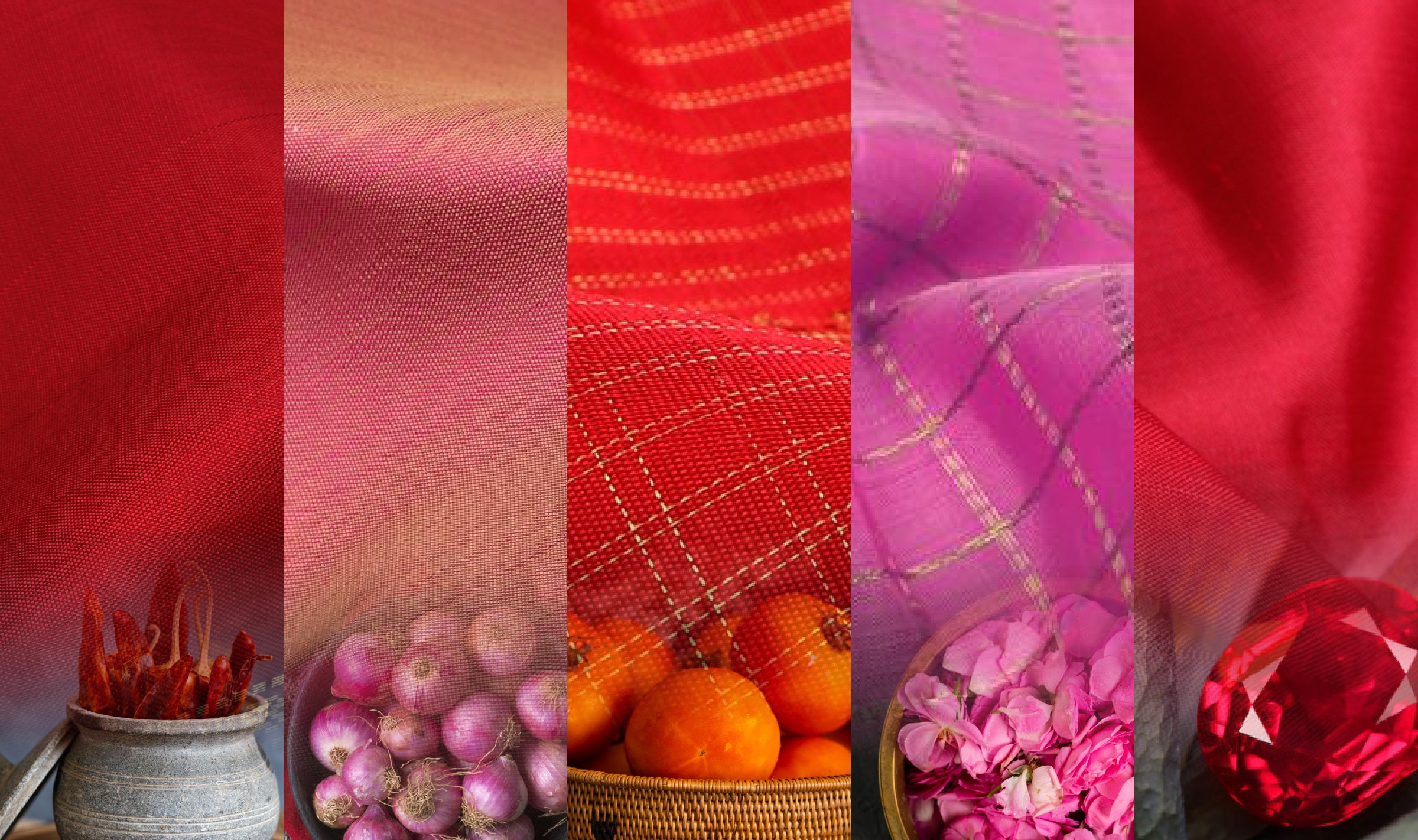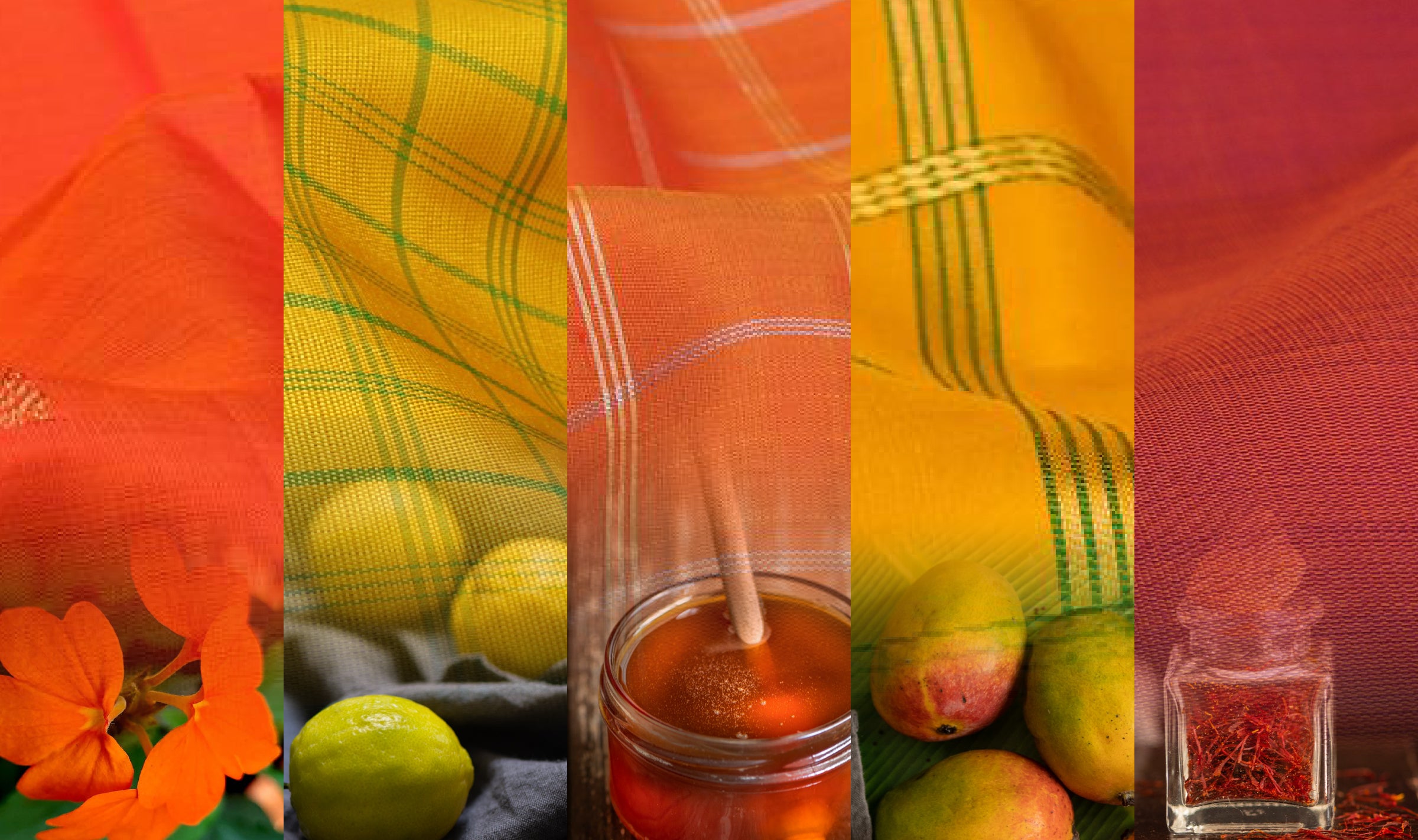Varna Sutra: Nila - Infinity In Blues

In this edition of Varna Sutra, we turn to the colour of infinity, a symbol of vastness: the universally loved shades of blue or Nila. This is a colour spectrum that combines ancient spiritual connotations with references to popular culture and a sense of the contemporary. The weavers of Kanchipuram claim their descent from the Sage Markendaya, believed to be the weaver of the gods who first spun gold from the fibres of the lotus, a flower worn by Lord Mahavishnu. Through this series we continue to see how deeply the kanjivaram tradition is entrenched in the religion and mythology of South India.
The Pallavas of Kanchi were instrumental in building and patronizing two monumental architectural structures in the eighth century – Kailasanatha temple for Lord Shiva and Parameswara Vinnanagaram (translating to the supreme lord residing in ‘vinn’ meaning sky and ‘nagaram’ meaning abode) for Vaikuntha Perumal. Both these temples are characteristically Tamil in style, and indicate a vigorous local art tradition. The Lord of Vaikuntha resides in this ‘sky town’, and is represented in three forms on three tiers of this heritage temple.
As Parameswara, Vishnu is represented in a dark shade of blue which characterises most of his incarnations - the colour of the sky and the ocean on which he reclines. The Lord is referred to as the one with skin the colour of dark blue rain clouds or megha varnam, according to Vishnu Sahasranamam (the thousand chants of Lord Vishnu). While Vishnu is depicted in blue, the dual form (Ardhanareeshwara) of Lord Shiva is described as nila lohita, a deep purple complexion derived from a combination of blue and red. Silpa Ratna mentions blue as Mularanga, the primary colour. India’s rich textile history and its mastery over indigo launched a thousand fleets of the world to trade with us. The tinted cloth of natural indigo was called nila and remains, till today, one of the most loved dyes for fabrics in the country.
In Christianity, the sacred colour invokes the Madonna who is also draped in a heavenly shade of blue. When drawing parallels in a study of the roots of nila or blue, the Scrovegni Chapel comes to mind, with its brilliant frescos in blue and gold on its walls and ceiling. Closer home, our Mahakavi Subramaniya Bharathi weaves a romantic “Karu neela pudavai” for his muse, Kannamma:
“Suttum vizhi sudar than Kannamma, suriya chandiraro? (Your eyes are so sharp and full of fire, Kannamma – is it the sun or the moon?)
Vattakkariya vizhi - Kannamma! Vanakkarumai kollo? (Have your round and black eyes taken their darkness from the sky)?
Pattu karuneela pudavai padhittha nalvayiram; Natta nadunisiyil theriyum natchathirangalladi! (In the middle of the night, the sky resembles a dark blue silk saree, with the twinkling stars taking the form of diamond motifs)”
These immortal lyrics have made every woman dream of owning that most desirable of kanjivarams, in a shade of karu neelam or dark blue sprinkled with zari motifs like stars.
The very local names of the kanjivaram’s colours depicting nature’s richness, culture and mythologies have also found expression in Tamil film songs. Who can forget the famous song “Neela Vanna Kanna Vaada” from the movie Mangaiyar Thilagam starring Padmini and Sivaji Ganesan? Listen to this evergreen classic sung by Balasaraswathi Devi in a medley of ragas bringing out the hues of emotions.
The response to colour is fundamental in human beings. No wonder colour plays such a significant role in our lives: in the clothes we wear, the festivals we celebrate and the ways in which we represent our beliefs and cultures. From the colours we paint ourselves in for Holi to the palettes of our favourite kanjivarams, we are expressing our essential love for colour.
In this curation, we explore the many ways in which the colour blue and with it, shades of purples, are brought to life on the fine kanjivaram silk.

MS Blue – Synonymous with the legendary Carnatic vocalist and Bharat Ratna M. S. Subbulakshmi, this shade of ‘middle sea blue’ is a must have in every kanjivaram wardrobe.
In this clipping of MS’s famous song “Katrinile Varum Geetham” from the movie Meera (1947), she emphasises the words and refers to Krishna as “Neela Nirathu Balagan oruvan Kuzhal Oodhi Nindran” (the blue boy who plays the flute) in her beautiful voice. One can only imagine why MS loved the colour so! (2:40th minute in this video)

Ananda blue – This vivid shade of sky blue has a reference to Lord Krishna, whose eternal presence and radiance brings happiness, or ananda.

Navy – The very dark shade of blue which was worn by the officers in the British Royal Navy as uniforms. Navy blue on the kanjivaram silk is like the midnight sky, often dotted with zari motifs like stars.

Nilambari (indigo) – The dark blue-black hue of Benarasi and Jamdani weaves has influenced the naming of colours in the kanjivaram tradition too.

Ink blue – The deep blue of ink traditionally used in fountain pens, lends the silk a gorgeous glow.

Sky blue – A delightfully bright blue; a celestial colour resembling the sky at noon.

Krishna Meghavarnam - A beautiful two-toned shade of violet shot with arakku or red. It is the colour of dark rain clouds associated with Lord Krishna, or Shyama, as he is referred to.

Turquoise blue – This gorgeous blue green gemstone that is a phosphate of aluminium and copper evolved into an object of interaction and exchange among the empires of early Islamic Eurasia. The association with the Turks and the trade routes that carried the gem across the Ottoman Empire to Europe made this a ‘Turkish stone’. Emperor Jahangir was gifted a turquoise stone from the Safavid Shah of Iran in 1613. The cerulean shade which acquired significance as a sacred stone has found its way into our sari colours too.

Sapphire blue –Lovingly called ‘sappair’ (also ‘neelam’) in Tamil, this hue highlights our love for gemstones, in particular the nine stones of the Navaratna. This precious light blue stone is worn to ward off the effects of Saturn in astrology, and its colour comes alive on the exquisite silken drape.

Copper sulphate blue – This distinctive shade of blue, rich and vivid, draws its name from the chemical compound and is widely used in the kanjivaram.

Ramar blue – This delicate blue hue with hints of green is very popular is South India, especially found in the Golu dolls of Rama during the Navarathri festival. People celebrate this festival for nine nights by displaying dolls creatively in their homes, and by dressing up in their finest silks.

Kathiripoo – Kathiri, meaning eggplant or aubergine, has a profusion of regional names. Only in a kanjivaram sari can one identify the myriad beautiful shades of purple of both the fruit and its flower.

Lavender – Derived from the pastel colours of the flower, this light purple is a very rare shade in the kanjivaram tradition, but subtly accents the drape of the silk.

December poo – December Poo blooms in the winter months, from December to February, and comes in yellow, white, light and dark pink and in light violet shades. The distinctive purple tone has found its place in the kanjivaram.

Vadamalli – The colloquial name for the colour of the globe amaranth or bachelor button flower. A beautiful purple shot with pink, this shade is a favourite among many kanjivaram collectors.

Naval pazham – The crimson and purple hued berries of the jamun, a fruiting tree indigenous to the Indian subcontinent, are considered auspicious in South India. This tree is the sthala vruksham (sacred tree) of the famous Thiruvanaikaval (Akilandeswari) temple near Trichy.
Ranging from the subtle to the startling, the gently romantic to the bold and dramatic, the varied exquisite expressions of the colour blue in the kanjivaram are celebrated in this curation. Taking inspiration from flowers and mythology, from ancient history and popular culture, each shade of blue weaves a story in silk. Read the rest of Kanakavalli’s Varna Sutra series to learn more about the hues that give life and beauty to the kanjivaram drape.
- Sreemathy Mohan



